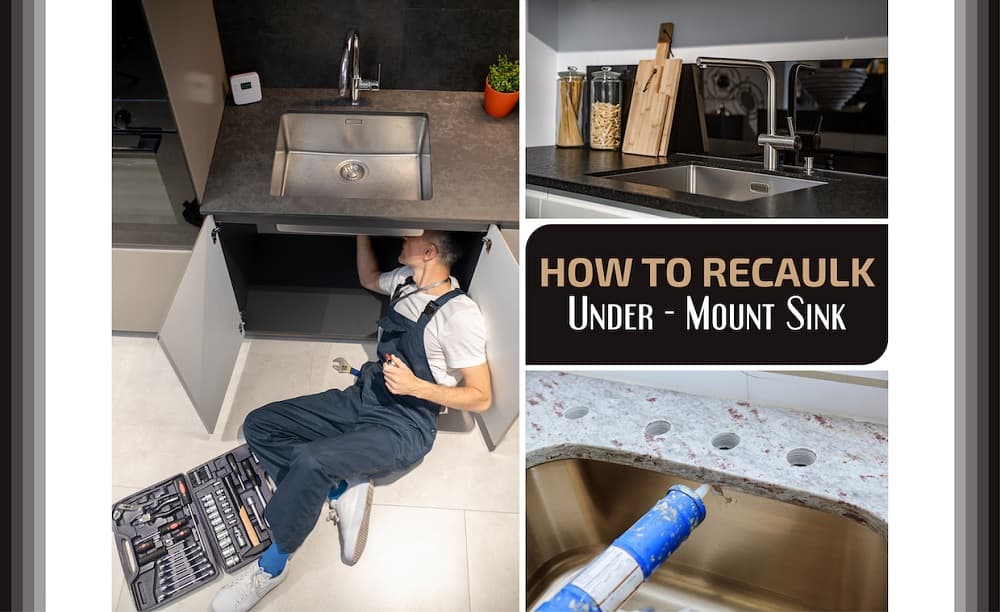
In this blog, Gharpedia brings all the basic details about types of kitchen sinks and a detailed guide on how to reseal an under-mount sink.
Do you ever notice that water often accumulates around your kitchen sink, causing soap scum and mould to form on the rim of the sink?
It’s a common problem that can be a pain to constantly clean up, especially when you have so many other things to clean in your kitchen. Bondzil’s granite countertop silicone sealant might do the trick for you.
However, there are two types of kitchen sinks:
- Drop-In
- Under-Mount
Unless you have an integrated sink where the countertop and sink are all one piece, your sink likely falls into one of these categories.
The good news is that under-mount sinks can help you avoid the water build-up problem, making it easier to keep your sink clean without constantly having to scrub away at it.
What is the Difference Between Drop-In and Under-Mount Sinks?
The two types of kitchen sinks are drop-in and under-mount sinks, and the main difference between them is in how they are installed.
Drop-in Sink

Drop-in sinks are designed to “drop in” to a hole in the countertop, with the rim of the sink resting on top of the countertop surface.
The weight of the sink is supported by the countertop, and the rim of the sink is visible above the countertop surface.
This type of sink is easier to install and can be less expensive than an under-mount sink.
However, because the rim of the sink sits on top of the countertop, it can be harder to keep clean, as water and debris can collect around the rim.
Under-Mount Sink

On the other hand, under-mount sinks are installed from underneath the countertop.
The sink is attached to the underside of the countertop with clips or silicone sealant for the kitchen sink, so the rim of the sink is not visible above the countertop surface.
This type of sink creates a seamless, clean look and makes it easier to wipe water and debris directly into the sink.
However, under-mount sinks can be more expensive and more difficult to install than drop-in sinks, and they may require additional support structures underneath the countertop to bear the weight of the sink.
To summarize the foundational difference between these two sinks, we can say, Drop-in sinks are installed on top of the countertop, while under-mount sinks are installed underneath the countertop.
Drop-in sinks are easier to install and less expensive, but they can be harder to keep clean because the rim of the sink can collect water and debris.
Under mount sinks look cleaner and are easier to clean because there is no rim, but they can be more expensive and harder to install because they require additional support structures.
But how do you ensure your under-mount sink stays fixed?
One of the simple answer is by using a good-quality waterproof silicone sealant.
But, do you know how to reseal an under-mount sink? If no, then no worries, go through the below guide on re-caulk an under-mount sink.
How to Reseal an Under-Mount Sink?
Required Materials and Tools for Reseal

Materials or tools you require for perfectly sealing your under-mount sink:
- Silicone Sealant
- Caulk Gun
- Razor Blade
- Mineral Spirits or Rubbing Alcohol
- Clean Cloth or Paper Towels
Steps to Re-caulk an Under-Mount Sink

- First and foremost step for under-mount sink reseal, you need to turn off the water supply and disconnect the sink drain and faucet.
- Then, carefully remove old sealant from around the sink with a sharp blade. Next, you’re required to clean the area with mineral spirits or rubbing alcohol.
- Here comes the fun part where you load the bottom sink repair sealant into the caulk gun and apply a continuous bead around the sink perimeter where it meets the countertop.
- Use your finger or a smoothing tool to smooth and press the Under-mount sink sealant into the gap between the sink and the countertop.
- Wipe away excess sealant with a clean cloth or paper towel.
- Allow the sealant to dry completely according to the instructions.
- Reconnect the drain and faucet, turn on the water supply, and check for leaks.
- By following these steps, you can successfully seal your under-mount sink and prevent water from seeping between the sink and Granite countertop.
Steps to Consider after Reseal Under-Mount Sink

Once your under-mount sink reseal is complete, you should verify that everything is working properly.
- Ensure that the sink is aligned properly and that it is sealed properly by gently pulling and pushing on it.
- To ensure that the water flows properly, turn on the water and ensure there are no leaks.
- Last but not least, make sure the sink is properly maintained.
- Ensure that there are no cracks or mouldy caulks and replace them if necessary.
- If you want your under-sink to last for a long time, you should consider changing the silicone sealant or adding another layer to it every three to five years.
- When properly maintained, with the help of an under-mount sink sealant, your sink will last a lifetime and will never weaken or damage your countertop.
I hope, this re-caulk an under-mount sink guide clear your all doubts about how to reseal an under-mount sink in your kitchen. For more information on Granite Countertop silicone sealant, contact Bondzil’s team of experts.






























